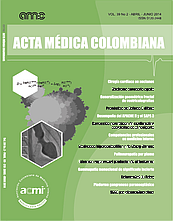Characterization of prognostic factors to diagnosis of patients with diffuse large B cell lymphoma
Abstract
Objective: to describe demographic, clinical, hematological, and immunohistochemical and biochemical prognostic factors to the diagnosis of patients with diffuse large B cell lymphoma and itsassociation with the severity according to the International Prognostic Index in a University Hospital,2009-2012.
Methods: a descriptive study was conducted in 40 patients with this lymphoma. ß2 microglobulinconcentration was compared with prognostic factors that compose the IPI and others which are not part of it; the association between IPI and revised IPI and ß2 microglobulin concentration, bone marrow infiltration, bulky mass and expression of BCL -2 and Ki p-67 was determined. Data was analyzed in SPSS.
Results: 40% of the patients were in the high risk group according to IPI and 55% to the group with poor prognosis according to the revised IPI; 82.5% expressed BCL-2 and 61.5% had a Ki-67 > 70%. Association between ß2 microglobulin and Ann Arbor (p = 0.036), the ß2 microglobulin and bone marrow infiltration (p = 0.003), and ß2 microglobulin and revised IPI (p = 0.037) was observed.
Conclusions: it is likely that the time between onset of symptoms and diagnosis has favored tha patients presented in advanced stages of the disease and as a result, with a poor prognosis. Likewise, the study of bone marrow infiltration, the percentage of Ki-67 expression and the concentration of ß2 microglobulin favors the identification of patients with an adverse prognosis.
Metrics
Acta Medica Colombiana uses the CC-BY 4.0 license. Authors retain all rights over their work.


